
Watering Marijuana Plants:
Cannabis plants use a lot of water, and regardless of what sort of setup you’re using, you’re going to want to make sure you have plenty of it. Water acts a vehicle for dissolved nutrients and minerals, being absorbed through the roots before spreading through the rest of the plant. It also cools a plant down, fills up cells to keep the plant structurally sound, and is required for photosynthesis.
All plants, including marijuana, consist of about 80% water. Therefore it makes sense that issues with water management could cause damage to a marijuana plant. Outdoors, a marijuana plant usually has enough water in the soil and from nature. Depending on the quality and the structure of the soil, it can also help regulate the amount of moisture. When growing indoors using pots, however, it is very easy to give your plant too much or too little water.
There are no hard and fast rules when it comes to watering a cannabis plant since the amount of water that you’ll need is based on the environment it’s growing in. In general, water enough so that your soil is faintly moist, but not wet. If the environment is very hot, the plant will use more water, but you should never give a marijuana plant more water than it can absorb.
If it seems like you are giving your plants a lot of water, don’t worry. A marijuana plant can consume a lot of water, but a large portion of the water is also excreted from the plant through evaporation from the leaves. Only a small amount of water remains behind and is used as building blocks. Water also helps to absorb and transport nutrient salts and carbohydrates, enabling life.
Understanding how to water correctly can make a substantial difference in the quality of your harvest. This guide will explain how to identify, schedule and deliver this vital ingredient for a growing marijuana plant.
Water Sources
The quality of the water you give your plants makes a difference. Ideally, you could use filtered, or reverse osmosis water, but you may have some trouble finding reverse osmosis systems in a lot of hydroponics and gardening supply shops, depending on where you live. Most growers simply use tap water. Some places are blessed with pure tap water from municipal systems or wells. However, most places in Europe and North America, are likely to have some impurities in their tap water, especially in large cities.
Regardless of the source of your tap water, most tap water will contain extra minerals. The type of minerals depends on your location, but Calcium, Sodium, and Magnesium are common. The harder your water is, the more minerals it will contain, and there is a vast variety of potential minerals that your water could contain. Some water companies know which minerals are in the water and can tell you if you ask, but sometimes they don’t. While the severity of these impurities can vary, many growers crave precision in their operations, and tap water can sometimes have too many unknown variables.
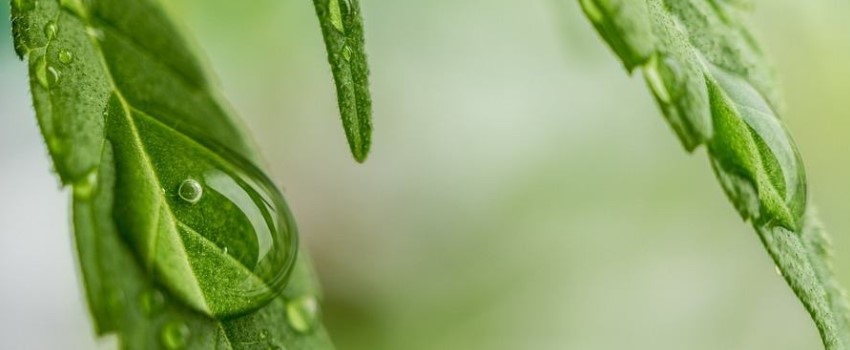
If you are not using filtered of reverse osmosis water, you’ll want to test your water to make sure it is suitable to feed to your plants. In terms of its ability to carry nutrients (EC), tap water can have an EC that ranges from 0.2 to 0.8, or even higher. It can also have various pH levels, but water for feeding should be between 6.0 and 6.5. The real issue here is that even when you take an accurate measurement, there is no way for you to know what sort of elements are in your water or the ratio at which they occur. This means that all the extra money you’ve spent on expensive, carefully measured nutrients is for naught: the mix is instantly unbalanced by an unknown quantity of other nutrients. In a worst-case scenario, this can cause nutrient burns or lock-outs and inhibit the growth of your plants.
You can also use rainwater, although it is not always better than some tap water. If you collect rainwater to water your plants, store it in food-grade plastic containers to prevent any airborne contaminants from entering the supply.
Water temperature is also important. Your water should be room temperature of around 20 degrees Celsius, 68 degrees Fahrenheit. If it is too hot or cold, the roots could experience thermic shock.
When to Water
You need to maintain proper water balance from the very beginning – before your seed has even germinated into a seedling. Since the seeds don’t have any roots, they will die if they dry out, but they will also drown if there’s too much water. When it comes to watering your marijuana plants, some factors will determine how much and how often you should be watering. These factors include the size of the plant, the size of the container your plant is growing in, the canopy, the root level, the temperature of the grow room, the humidity level, and which stage of growth your plant is currently in. A good rule of thumb is to wait until the soil is drying (but not yet completely dry) and then water it enough to last it until the next scheduled watering.
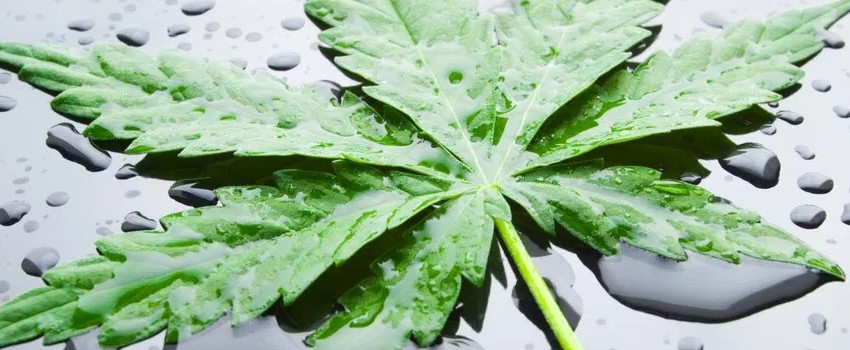
Seedlings
Usually, it’s advisable to keep seedlings and young sprouts hydrated by spraying or misting them with water. This helps to ensure you don’t drown them by watering them too heavily. Once the seedlings have rooted down, you can start using a watering can.
Developed Plants
As the seedlings root down and grow, you can let the soil dry out for brief periods of time. These short dry periods will help limit the risks of your soil developing any mold or fungal growth, which can sicken and destroy a seedling. Just remember to water the plant regularly, but don’t let the soil get too wet or too dry. If you are growing in a different medium, such as coco coir, you can water every day or two.
The morning is the best time for you to water your plants. That way your plant has a whole day of sunlight and chemical processes that it can use the water for. Watering in the evening increases the chances that you will have to deal with fungus or mold. If you are adding nutrients to your water, water it a little more, to encourage runoff and prevent nutrient buildup. If you water your plants incorrectly, the roots of your marijuana plants could dry out or start to rot. In either case, the effects are detrimental to the health of your plant.
How Much Water
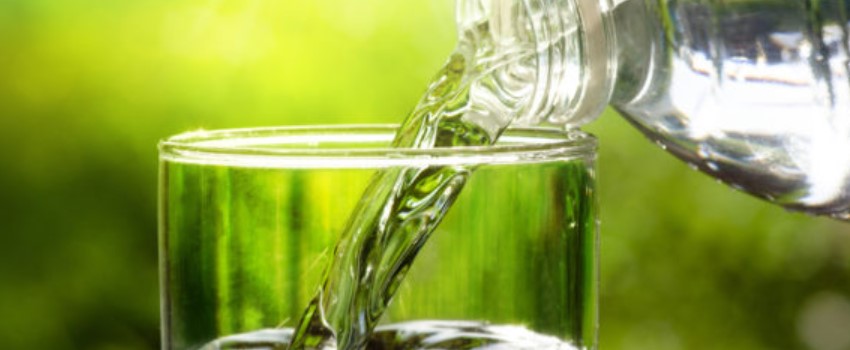
In terms of how much water you should give your plants, that number can vary as well. It is based on the size of the plant, the temperature, the composition of your soil or substrate, the properties of the water you’re using, and the capacity of your air filtration systems.
When your plants mature, the environment gets warmer and less moist, and the plants will need greater air flow and additional water. Large leaves widen the surface area on which evaporation can occur. The metabolic process is activated by heat and transpired moisture is blown away, causing plants to transpire more. Therefore, larger plants generally need more water than smaller plants.
You should also keep in mind that larger containers won’t need to be watered as extensively and that plants in the final stages of the flowering phase consume less water and therefore need less. In terms of the temperature outdoors, you should water more during hot weather, but if the humidity level is high, then you should not water as much.
Sometimes growers simply lift up the pot their plant is growing in to see if it feels light or not. If it feels light to them, most of the moisture is gone and, therefore, the time for watering their plant has come. At first, this might be difficult for people new to this method so you can compare it with another pot that you fill with the same growing medium – but don’t water it. This will help you know what a “light” pot should feel like. When you do this, you can lift the actual pot with the plant in it up to see if it is similar in weight to the dummy pot. After some experience with this, you should no longer require the dummy pot to know if your plant needs watering or not.
Regardless of how much water you end up giving your plants, do so slowly. If you give your plants too much water at once, you’ll form tiny channels. Water drains quickly out of these channels, and it won’t be absorbed by the roots. Always water your plants slowly and evenly to ensure proper hydration and distribution of nutrients.
Drainage
When growing marijuana in pots, water needs to be able to drain freely through the bottom. This prevents the plant from becoming waterlogged and developing the symptoms of overwatering. When you water your plants, check to see that the water is draining from the bottom. If it is not, your growing medium may not be ideal.
What should you do with that drainage water? Although many pots will come with little trays that hold it for you, you’re better off throwing that water out. Letting the water sit for long periods of time is just begging for the accumulation of bacteria.
Common Watering Issues
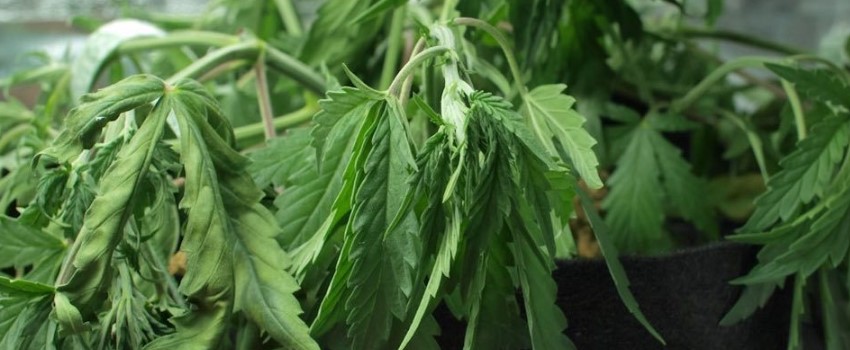
When watering isn’t done correctly, you’ll start to notice it in your plants. Symptoms of a watering problem can appear in the leaves, stems or even the roots. Even if your plants are grown hydroponically, you could notice watering-related issues develop in the root system. Many times, a root problem is the actual source of many other plant problems (such as wilting or drooping), and its ‘root issue’ is watering.
Symptoms of a Watering Problem
Leaf Symptoms:
– Brown leaves
– Burnt leaves
– Upper leaves and newer growth affected
– Lower leaves and older growth affected
– All leaves affected
– Leaf tips are burnt
– Spots appear
– Slowed growth
– Leaves curling under
Plant Symptoms:
– Weakened stems
– Slowed growth
– Plant wilting
– Plant drooping
Root Systems:
– Brown
– Smelly
– Mushy
– Slowed growth
If your roots have been damaged, it can take the plant a long time to recover. Plus, a lot of other things could go horribly wrong before that recovery occurs. Plants with damaged roots lose their vitality and become very vulnerable to pests and diseases. Therefore, if you damage your roots from overwatering, you could easily kill the plant. Below are some specific watering problems as well as how to fix them.
Overwatering
The number one issue around hydrating plants is over-watering. Overwatering is a serious mistake that is very common among new marijuana growers because the assumption is that since water is needed, too much of a good thing can’t be bad. Don’t make this mistake. If you are overwatering your plants, their roots will start to drown causing the growth of your plant to slow down or even stop. This happens because of the anaerobic condition that develops from an overwatered plant. Too much water can moisten the valuable air pockets where oxygen is stored, making less oxygen available for the roots to absorb. The roots will consequently function incorrectly, lose their strength and potentially fall victim to pathogens.
Overwatering is unlikely to occur if your plants are in the ground since excess water will be absorbed by the surrounding soil, but it can happen in areas with poor soil. Clay-based soils or soil that experiences heavy rainfall will not drain well. On the other hand, sandy soils might have drainage rates that are too fast. Know your soil and adjust your watering routine accordingly. The most basic way of combating an overwatering problem is to add in time between each scheduled watering, then allowing your plant some extra time to absorb smaller amounts of water until it appears happy and healthy again.
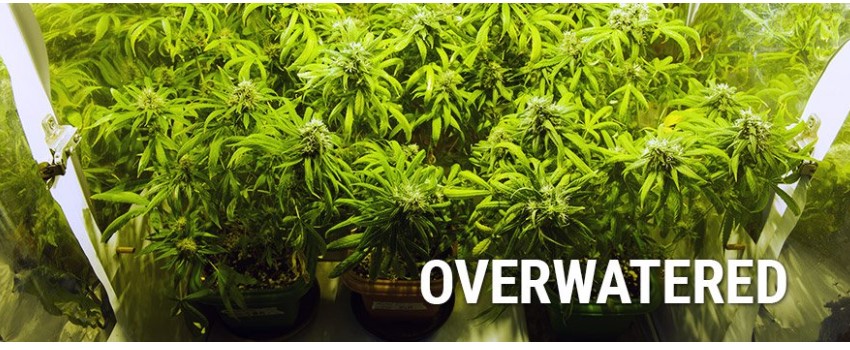
If your marijuana plants are in pots, it is easy to overwater. Without proper drainage, water will accumulate and drown the roots. Even with proper drainage, the roots could still receive too much water if it is happening too often. This should be avoided, because, overwatering – especially in containers — can cause a plant to develop root rot and slowly die.
Because overwatering starts at the roots, you may not see any discoloration to indicate a problem, such as with issues from other environmental problems. You will notice that the leaves begin drooping and the overall look of your plant will be tired and unhealthy. Sometimes chlorosis or yellowing of the leaves develops, but you shouldn’t think you are fine simply because the leaves aren’t yellow. You should also not confuse drooping with wilting as they are caused by different problems. Drooping leaves mean the entire leaf is curling under or hanging in a manner that looks sad, not just the tips of the leaves. You may also notice leaves beginning to fall off – even ones that look healthy! This is never a good sign.
Too much water is also problematic because it can prevent the plant from absorbing enough nutrients. The water is literally washing out the vital nutrients that a plant needs before it has a chance to absorb them. Plus, if your soil is always wet, there’s also a considerable risk of fungal growth and mold.
How to stop overwatering
Overwatering is often caused by human error. Remember, unless you are growing marijuana in a very arid environment, your marijuana plants will only need water two or three times a week. Not watering as often does a lot to prevent overwatering. It’s also very easy to overwater small plants in large containers, so choose your containers wisely.
If you are following a schedule and it is still happening, the easiest way to prevent it is by checking the soil before you water. Insert a ruler a few inches into the soil, and if it comes out dry, with no soil adhering, it’s time to water. The reason for using the ruler is that the topsoil is not indicative of the moistness of the rest of the soil.
Between watering, check the moisture of your soil. Make sure your substrate isn’t constantly soaking wet. If it is, you need to make adjustments. If you’ve been overwatering, stop ASAP and give the plant only tiny bits of water until the roots are white and healthy again. If you are using an irrigation system, then you’ll have to adjust either the flow of the water or the distance of the spouts from the plant.
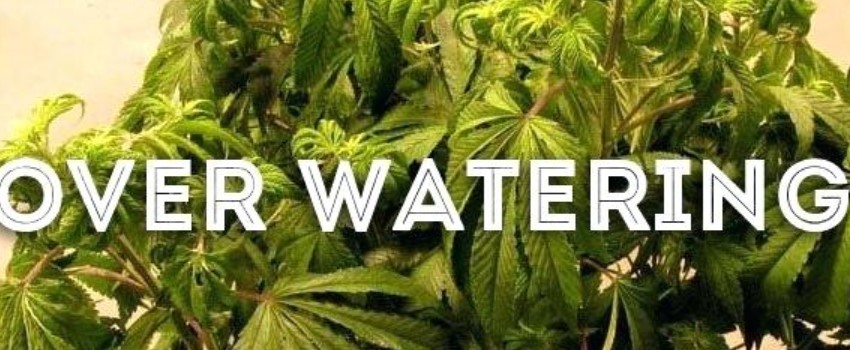
Sometimes overwatering is caused by drainage issues. This could be due to the soil or the container. Marijuana soil should be coarse and well-aerated. To prevent overwatering, when you water, always check to see that about 20% of the water drains from the bottom of the container. If you notice the soil remaining damp for a significant amount of time, either the drainage needs to change, or your amount of watering needs to change. If there aren’t any drainage holes to begin with, cut them with a knife, drill, or heat-based tool. Drainage holes are crucial for your plant’s root health. You can also help aerate soil by poking holes into the soil with a pen or pencil, which helps decrease moisture and increase the amount of oxygen held in the soil.
If you have a drainage problem, it is very hard to water correctly. You’ll need to start inspecting. Perhaps the drainage holes are blocked. Maybe the soil has particles that are too small, meaning they are packed together more tightly and don’t let water flow through as easily. Check if this is the problem by watering the mix and seeing whether the water drains out freely. If it doesn’t or comes out quite slowly, the problem is probably the particle size of your soil or planting mix. It is draining too slowly if it takes more than a minute or two for you to see water coming out of the bottom.
If you have a drainage problem, you’ll either need to water your plants less often, fix your container, transplant into a different container or find a different medium.
Treating Root Rot
Overwatering can cause root rot, which occurs when roots are deprived of oxygen, and it could kill your marijuana plant. Root rot can also occur in a hydroponic setup. In this case, it is not from overwatering, but from poor aeration. This could mean root rot is not allowing the roots to absorb enough oxygen, or that not enough oxygen has been dissolved in the water.
Root rot can be treated. A slightly involved way to quickly do so is adding a small amount (a few tablespoons) of hydrogen peroxide to your water. This works because the chemical compound contains oxygen and can feed the roots. Hydrogen peroxide also has an added benefit: it will kill bacteria in your soil that started thriving because of the rot. Your other option is removing the plant, inspecting the roots, cutting off the affected areas, and transplanting it elsewhere. Hydro growers can use an air pump or air stones to solve this problem.
Underwatering
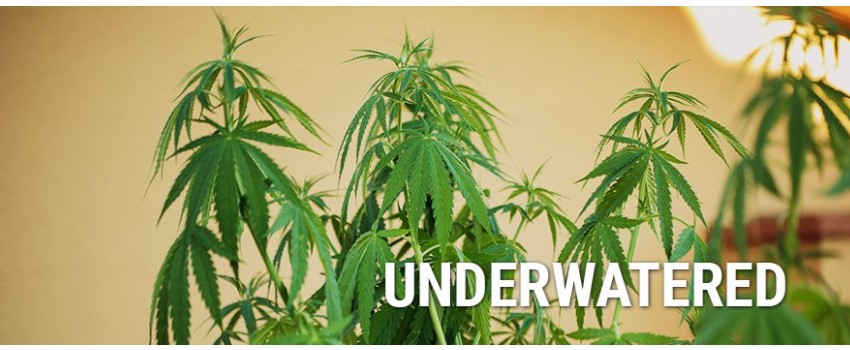
Underwatering is not as dangerous as overwatering, but it is still a problem. Its effects will look similar, except you will definitely notice leaves falling off and they will look shriveled and decimated.
When a plant has been underwatered, it can literally die of thirst. As it starts to wither, it is using all the available resources and will sacrifice the leaves first. This means that during this period of its vegetative state, a marijuana plant will stop producing new branches and leaves, limiting its potential. Even though you can correct the problem quite simply (add water), the effects may continue to be felt. Because the plant’s growth was stunted, your harvest may be smaller, and their smoke may be harsher than expected. If a plant doesn’t get enough hydration, it will not develop properly.
A lack of water can lead to many problems. Since water is essential for photosynthesis, the lack thereof will reduce the photosynthesis in the plant. Furthermore, to carefully manage the available water, the plant will close the stomata on its leaves. As a result, less water evaporates, and therefore the plant also absorbs less water. Consequently, it also means that no CO2 can go through the plant.
The lack of water supply also causes stagnation of the nutrient supply from the ground. Not enough nutrients mean a shortage in protein production. The marijuana plant will show signs of nutritional deficiency in no time. Adding fertilizer is useless because the plant can’t absorb it anyway due to the lack of water. So, the symptoms of such a nutritional deficiency are therefore secondary. It’s always important to identify the primary issue (shortage) of a sick marijuana plant because otherwise, the problems will just get worse.
Underwatering also causes a plant to breathe faster. This is because the plant must put in a lot more effort to loosen the remaining water in the ground. This takes a lot of energy from the plant – energy that can no longer be diverted to growth and flowering.
Are you watering enough?
Underwatering is often caused by grower error, but some outdoor grown plants can experience drought and experience its effects as well. So regardless of where you grow, you need to be concerned about underwatering.
Many growers do not know they are underwatering until it is too late. This is because it’s hard to know if your plants have enough water; slowed growth is sometimes difficult to notice. There are some leaf symptoms, but they will look a lot like the ones you’d see if you were giving it too much water. Some unique features of underwatering include:
- leaves becoming brighter
- leaves that shrivel suddenly
- leaves that wither
The most common giveaway is wilting, rather than drooping. Plants that wilt are likely not receiving enough water. If you suspect your plant is not receiving enough water, try giving it more. If you notice a significant growth spurt, that was likely your problem.
Safely treating an underwatered marijuana plant
Underwatering is easy to fix; simply give the plant water. However, prolonged cases can do significant damage to a plant. When a plant is near collapse, it’s challenging for it to bounce back and recover. If you are attempting to nurse a plant back to life, don’t use water that has been enriched with any fertilizer, since that will not help. Instead, use neutral, pH-balanced water to re-hydrate your plants. Once they have stopped wilting and look like their normal, upright selves, you can go back to using fertilizer.
pH problems
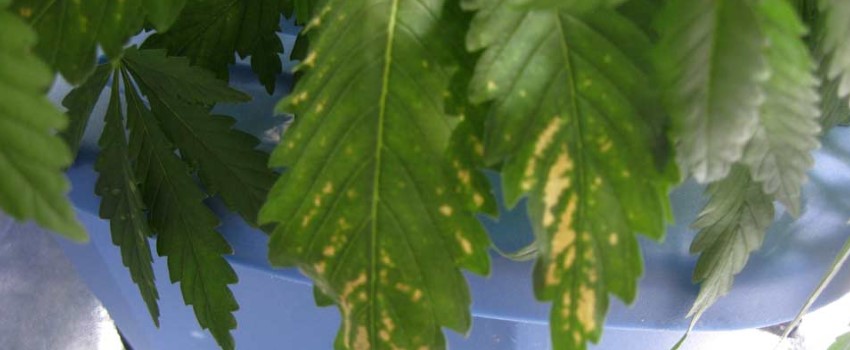
I get a lot of questions about watering marijuana plants. There are myriad things that can go wrong when growing marijuana, including watering too much or too little, but most of the problems that the grower can control revolve around PH levels. Your eyes are the first line of defense as you’ll be able to see problems ranging from misshapen or damaged leaves to fungus. pH problems can be caused by a variety of things, and sometimes, it is the pH of the actual water.
If you’re not guilty of overwatering or underwatering, but you are still noticing symptoms related to watering, you should check the pH of your water. Simply use a pH tester before you give the water to your plants. Electronic ones with digital displays are of course easier to use, but also more expensive. You can also use liquid pH testers, they do a good job but may be a bit more complicated to use. In a pinch, or if you are on a budget, pH strips will work, but they cannot be trusted entirely. If you find your readings are not jibing with what the plant or soil looks like, then the tester may be the problem.
Sometimes, pH is an indicator of a different problem. For example, you noticed that your soil has a nutrient deficiency, so you attempt to remedy the situation by doing something like adding Epsom salts or worm castings, or you mix in a balanced organic nutrient mix with your watering regimen. After about a week, the soil pH levels begin to rise (soil is less acidic), but the plant’s problem is still apparent. Concerned, you add more nutrients either directly to the soil, or in a tea and the problem only seems to get worse, (the pH drops).
In cases like this, it is probably the water that is the problem, and so, before you completely lose your mind, check the water. Most major municipalities chlorinate their water to kill bacteria harmful to humans. This water should never be used when you are germinating marijuana seeds or flowering your plants, and if you must use it when your marijuana plants are in the vegetative growth stages, you should let it sit for at least twenty-four to forty-eight hours so that the chlorine can evaporate. Chlorine is very acidic and, once added, it can lower the pH levels in the soils preventing the absorption of whatever nutrient or supplement you are trying to add.
Water is essential for your marijuana plant. Without the correct amounts, your plant will die. Without the right type, it may be starved of nutrients. If your marijuana plant starts to suffer in any way, always check the water first.
0 Comment:
Post a Comment